So, you’re thinking about launching a podcast…
The medium is exploding right now, so now is the time to jump in.
And when I say exploding, I’m talking about a doubling in the number of listeners in just the last 24 months alone, with 10.1 million UK adults now listening to a podcast on a weekly basis according to the latest MIDAS report.
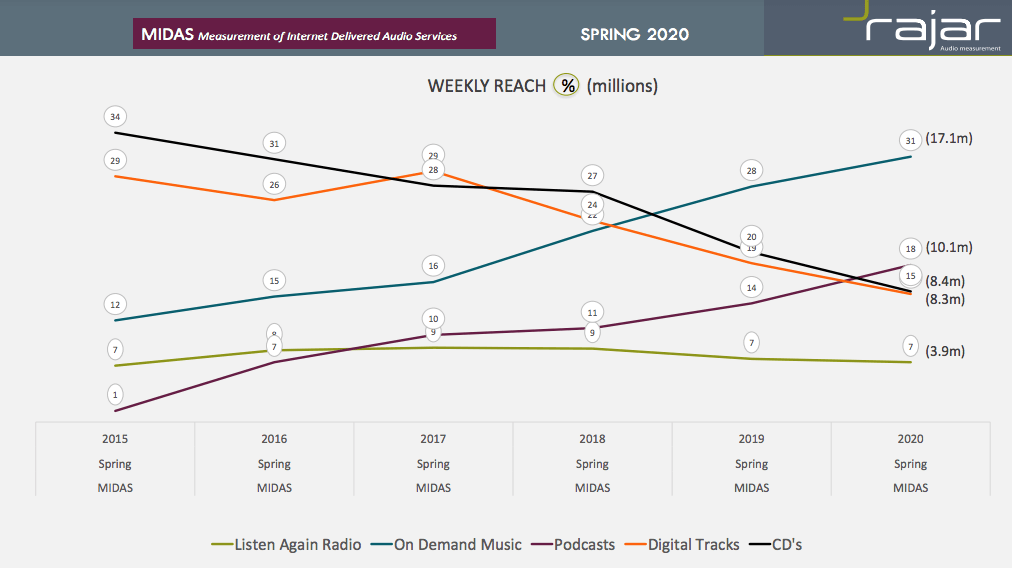
Not only has the doubling of the audience size made this a very valuable media format for marketers, brand builders and business owners, but the actual demographic of podcast listeners make them a highly-prized bunch of people to target as well.
Contents
The Right Kind of People
Podcast listeners tend to fit into the ABC1 socio-demographic profile meaning they are affluent, educated and have a disposable income.

The podcast audience is a proactive gang too and they respond very well to a call to action, making this is a very powerful CTA media format. Some recent research suggested that 56% will click a link ‘when instructed to do so by the show host’
Not only that, but a recent survey by 4DC showed that 59% ‘have bought or would buy from a brand advertised in a podcast’

Podcasting Changed My Life
Podcasts are a big opportunity if you get them right.
How do I know?
I launched a 7-figure coaching business off the back of my first ever show, which also led to a 6 figure branding agency business, which led to me fast becoming Europe’s leading expert in successful podcast launches, having now launched 125+ for clients (129 at the time of writing).
Podcasting (genuinely) changed my life and that is why I am so passionate about it.
Why Do You Want to Podcast?
In order to make this as impactful as possible let’s start right at the beginning. And the first question, as with all marketing, is WHY.
Why are you going to do a show? What is your desired outcome? What are the tangible and tactical goals that you want to achieve from starting your own show?
- Is it to create massive brand awareness – podcasts are great for that.
- Is it to reach a new network of valuable contacts by inviting tastemakers in your sector on to your show – podcasting works for that too.
- Is it to create expert positioning in the marketplace – a show ticks that box too.
Once you have your ‘why’ flip the question on its head; shift from what do you want to get, into what will you give i.e. what’s in it for ‘them’ (your audience).
This is a massive consideration – what is this new, organic, global audience going to get from your show? What education, information and entertainment can they expect to receive from you?
Don’t find customers for your products. Find products for your customers.
Seth Godin
I don’t want to teach you to suck eggs here – as you’re reading this very well respected blog I’m sure you’re someone who knows a thing or two about marketing – but two fundamental considerations are essential:
- What are you trying to achieve?
and
- What are you going to give listeners?
Brand Focus
Once you have an understanding of your why you can drill down into more detail and work on the ‘brand’ of your podcast.

I suggest going through the 7 points in this ‘Brand Overview Questionnaire’ to better understand the true focus of the show. Identify and write down your:
- Core Values
- USPs
- Mission Statement
- Value Proposition
- Ideal Listener Profile
- Stakeholders
- Target Market
This might sound like something you have done previously when looking at the marketing for your business – that’s because you need to think about the overall ‘brand’ of your podcast with the same level of focus.
Go through each of these points and come up with the appropriate brand answers for your targeted podcast.
Podcast Launch Considerations
Next, you need to think about the sort of show you want to release into the world. And, if you get this right, the world is exactly who might hear the show; podcasts give you an amazing ability to reach a global audience. We released a brand new show a few weeks ago and the client hit 43 countries in the first week.

Consider and formulate a plan for these 4 points:
Podcast Format:
Do you want to do solo episodes? Face to face interviews? 1-2-1? Or ‘round table’? Are you going to create an ongoing weekly show or create a ‘season or series’ format with a certain number of shows per series?
Podcast Frequency:
You must put content out once a week, at least. Anything less and it’s very hard to gain any genuine traction and sustain it. This is why a series can be great, as you can do a big push and make a lot of batched content, release it all over a 10-12 episode series, then take a break and go again.
Podcast Length:
One of our most commonly asked questions is: ‘How long should my podcast be?’ and the answer is ‘as long as it is interesting’. The shortest podcast is a minute and the longest is about 5 hours, so anything in-between those timescales is OK! Having said that, a lot of shows fall into a 30-60 minute timeframe (maybe it has something to do with the fact we are conditioned by traditional media like TV to consume for that sort of timescale).
Podcast Guests:
If you’re going to do an interview-based show, what access do you have (right now) to the sort of guests you want to feature? It can take time to build up the credibility of a show that attracts big hitter guests, so who can you get on right now, in your immediate network?
A Point of Difference
There is more focus, attention and, frankly, money coming into the sector than ever before, and that means that there are a lot of shows being launched at the moment.
When thinking about your show, analyse your point of difference from the existing marketplace.
One of the shows I’ve created is Building The Brand, it is a 1-2-1 interview format show about the world of branding. There is nothing unique about that, but, where the show differentiates itself is the depth of the conversations – I do more research on guests than is normal, I know more about their background than other podcast hosts and, because I am a businesses owner – who coaches other business owners – I frame the conversation in a way that actually gives tactical expertise that listeners can implement into their own businesses right away.
As I often say ‘tangible, actionable and usable content’. If you fancy hearing what I mean, check out the chat between myself and Einstein Marketer Founder, Mat Wilson!

Setting Up Your Show
You need to have a point of difference from what is already out there, and that means you’ll need to do a bit of digging on the ‘competition’. That digging is also going to help you with this next part; show setup.
I like to take my clients on a ‘platform walkaround’, so they can see the categories they are likely to feature in, take a look at the sort of artwork that other shows are using and get an idea of how important it is to stand out, quickly.

As you can see (above) when looking at the main platforms – such as Apple, Podcast and Spotify – there is not much of a ‘shop window’ for your show, so we must look at ensuring your artwork catches the eye and your show name resonates.
Artwork:
On iTunes – and the other audio directories – your show artwork is the first thing that people see. Before they ever hear your intro, voice or content they ‘see’ what you represent.
The browse categories on the podcast directories are like the aisle in a supermarket – you need to give listeners a reason to pick you from a lot of similar ‘products’.
Your Artwork must:
- Be clear, concise, easy to read
- Instantly communicate the identity of the show
- Grab attention
- Standout
- Resonate with the target listener
** Design tip: iTunes artwork must be:
Minimum 1400 x 1400 // Maximum 3000 x 3000

Your show name also has a role to play in ensuring that your ideal listener chooses you – when picking a name for your show consider:
- Is it unique?
- Does it do what it says on the tin?
- Is it SEO Friendly (search term, no alternate spellings)?
- Are the URL’s available?
- Is it easy to spell?
- Does it resonate with your target market?
Look at the category (or categories) that you think will be the best fit for your show and search for examples and trends.
Syndication Software
Once you have created your eye-catching artwork and intriguing name it’s time to set up the back-end systems that will enable people to consume your content.
You might not realise this, frankly, why would you unless you’re in the podcasting space, but when you download or stream a podcast from the likes of Apple or Spotify or TuneIn or Google Podcasts or Stitcher (or one of about 60 other android options) you are not actually getting the content from the platform directly, they are simplifying acting as the ‘middleman’.
An RSS platform enables you to publish your show. In the podcast world, this is often known as syndication software.
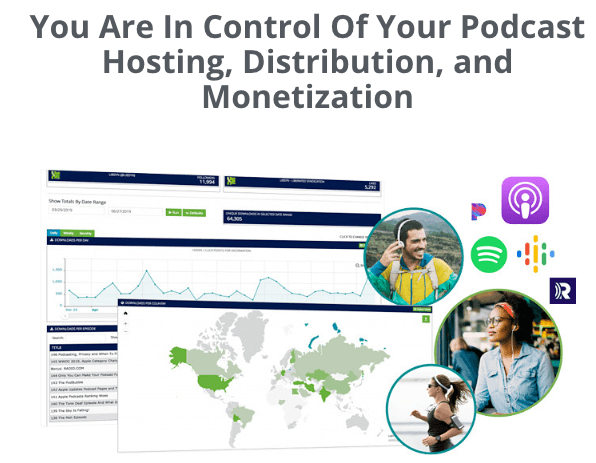
There are lots of these syndication platforms out there – and they largely do the same thing – but the one I would suggest you check out is Libsyn. They have been around since 2004 and are hosted on the AWS platform, so they have big server capacity.
By the way, if – after reading this – you want to get a Libsyn account, use the promo code ‘UPG’ and you’ll get up to 2 months free.
Setting Up For Success
Setting up the back-end of the syndication software properly could help your show get more attention, so make sure you spend a bit of time getting this right.
For example, keywords and SEO-friendly terms in the ‘show settings’ section might help your show rank for certain terms (I say ‘might’ because the big platforms have never given us a definitive answer about where they take keywords from, but I would guess that the show settings play a part, based on tests I’ve done!). It is often the syndication software that enables you to choose the categories that your show will feature in too, so that is also very important, obviously.
Top tip: At the time of writing, there are 19 categories within Apple Podcasts (and the other major apps take their lead from Apple, so they are all very similar – sometimes just with slightly different names). These categories include things such as News, Comedy, Business, Health & Fitness, Education etc. but there are also subcategories within those top-line categories.

For example in the Business category there are Investing, Marketing, Career, Entrepreneurship and Non-Profit subcategories, so – where possible – choose a subcategory to feature in as there are Top 50 curated lists of each subcategory and those are easier to rank in.
Being featured in these curated top 50 lists of the categories and subcategories can lead to organic, global reach for your content.

The good news is that once you setup your syndication software it is easy to get your show on all the major platforms in one go i.e. when I have an episode to release I just upload the mp3, show notes and any artwork to Libsyn and they publish the content on all the relevant platforms for me.
You’ll be pleased to know that when you’ve got the logistics in place, you can actually start to record some content! First, you’ll need some equipment…
Podcast Entry Level Equipment
The level of gear you need depends on the show you intend to make and how you intend to make it.
For example, if you’re doing remote interviews online with guests you will only need a simple USB mic and some software to record the audio – however, if you’re planning in-person interviews you might want something more sophisticated that records in higher quality.
Entry Level – Blue Snowball iCE
This is great for doing an online interview via something like Zoom or if you’re going to record a solo episode. Decent sound quality, easy to use and simple to set up.

Mid Level – Zoom H6
6 channel handheld portable recorder with 4 XLR inputs, multiple built-in mic capsules and USB interface. Creates immersive stereo sound in various formats with SD card memory.

Higher Spec – Rodecaster Pro
Fully integrated podcast studio in a box. This system enables multi-track recording, 4 high-quality microphone input channels, pre-recorded sound effects and built-in Micro SD card recording.

In order to record, edit and produce your podcast you will need a recording editing software. There are a mixture of options with a variety of prices and varied complexity levels but the best basic options – which are also free – are Audacity (Mac or PC) or Garageband (for Mac).

Audacity is an open-source editing software which is free of charge. It looks a bit dated, but it does everything you would need editing software to do – and its simplicity is great when you’re making podcasts.
You can record into the software (via a USB mic or larger studio setup) or drag and drop audio files in and just edit. Basic compressors, amplification and effects mean you can get a great sound without much effort.
There are some great YouTube videos on the essential basics of using Audacity, so watching those and having a ‘play’ with editing is the best way to get up and running with this software.
I have a 30-minute tutorial that will get you up and running with the basics, which you can see on my YouTube channel via
Polishing Your Podcast
When you’re up and running with the recording basics and editing essentials it is time to take a look at the simple things that can make your podcast stand out from the rest, and ensure your show sounds polished and professional.
One of those simple elements is your ‘theme music’. There are two places that you can use your music; one is the intro and the other is the outro, both of which play an important role for your show.
Your intro needs to ‘sell’ the show to your potential listener. It needs to grab their attention, hook their interest and give them a fast overview of what they will get from tuning in, whilst edifying your position as the host.
You never get a second chance to make a first impression.
Will Rogers
The intro needs to be short, sharp and to the point highlighting:
- What’s in it for your listeners
- What they are going to get from your show
- Who you are to warrant their time and attention
Ideally, intros and outros need to be around 30 seconds in length.
A pre-recorded outro is a great way to push people to undertake a Call To Action – which is usually most effective as a ‘click the link in the show notes’ style message, that drives the CTA.
The end of the show is also a great place to encourage social proof via online sharing – so feel free to include how listeners can share the show as part of the outro.
Your Podcast’s Music
There are loads of different platforms to get licence-free music (and yes, your intro and outro should be licence-free) but I suggest Premiumbeat. The platform has a huge library of tracks for $49 and, for that price, you are buying the licence, so you have the legal right to use that song on your podcast.

The licence-free side of things is very important as you do not want to fall foul of any copyright regulations as that could get your show pulled down from the major platforms.
Your Podcast’s Voiceover
The voice at the start and end of your show is the first and last thing your listeners will hear, so you need to make it count. You can do this intro and outro recording yourself if you want, but having a voice that is different to your own will stand out.
This is important because, as mentioned right back at the start, 56% of people will click the link in the show notes when instructed to, so you want to make sure that call to action messaging is heard.
Ideally, you want your intro and outros to be around 30 seconds, which is generally around 100 spoken words. When crafting a script for your voiceover artist (if you’re going to use one) aim for no more than 100 words and time yourself reading the ‘script’ a couple of times to make sure it is around the right length.
For a polished sound, it’s worth considering a professional voiceover artist. Costs of voiceover artists can range from a few quid to hundreds.
A new podcast doesn’t require a high spend on this though – look at some of the voice talents on Fiverr. Search for providers with a high rating that have an authentic voice for the region you want i.e. if you want a British voice get a British voiceover to record for you – not someone who is putting on an accent!
Tip: Make sure you’re very specific with your brief because amendments often come with additional costs.
Launching Your Podcast
Once all the hard work has been done it is time to get your new podcast launched!
I’d recommend that your podcast promotion process is done over a 14 day period with the aim of creating interest, increasing awareness and generating excitement about the launch of your show.
A fortnight of promotion is long enough for people to ‘buy in’ to the work and effort that you’re putting in to launch a show, but not too long that people get bored of you talking about your upcoming launch!
Over the 14-day promotional period, you need to ‘document the birth of the show’. Take people on the journey of creating your podcast and let them see the work that you put into creating your own branded audio content.
You need to engage, entertain and create intrigue about your show without boring people over this 14-day podcast launch period – mix up your content formats and messaging across videos, written posts, graphics etc.
Here are some content ideas:
Countdown Graphics (enables you to ‘warm-up’ your audience to the idea that your show is coming, creates familiarity with your artwork, but post different styles to keep engagement levels high)
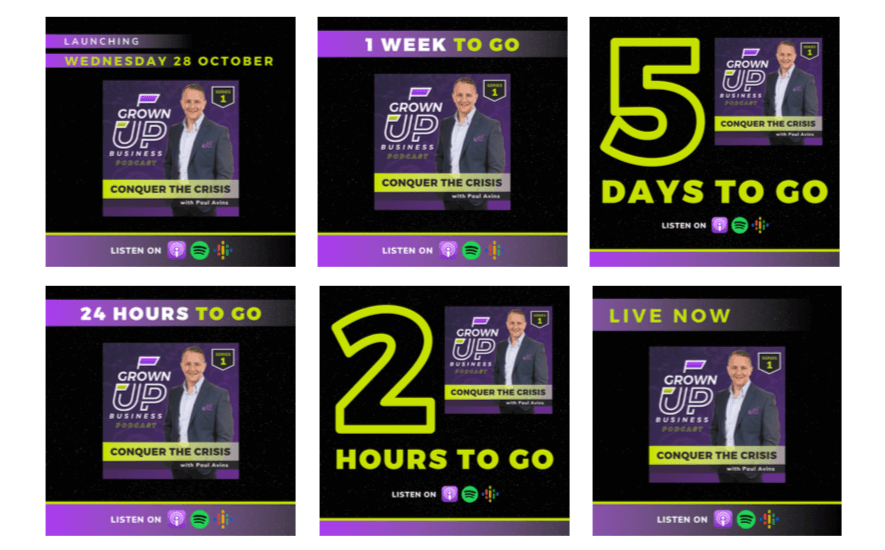
Name reveal (Don’t announce your podcast’s name at the start of the 14-day promo process as you want to be intentionally vague with specifics at the start – don’t forget to take your followers on a journey).
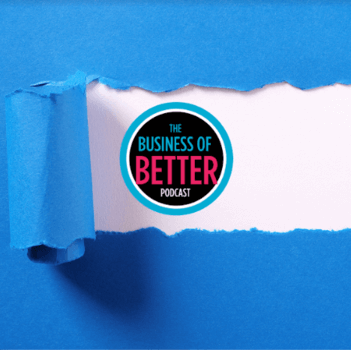
Artwork A/B Test (These are great for engaging the audience and making them feel like they are part of the journey of your podcast coming to life)

Behind The Scenes (show things like the team working on your show, you recording, learning the process etc.)

Audiogram graphic templates (There are some great software like Wavve and Headliner where you can add moving waveforms to static graphics to make videos which get much higher levels of engagement than just images, these work excellently for clips).
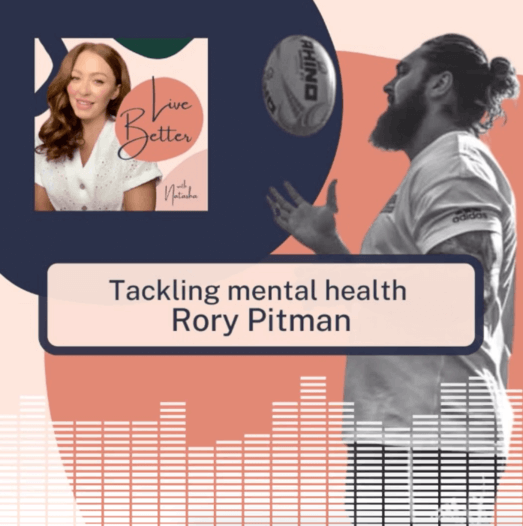
Quote graphics (Quotes from stand out moments of content shared by your guests work brilliantly to excite your audience. These graphics also have a great chance of being shared by the guest, which enables you to get your branding in front of their audience).
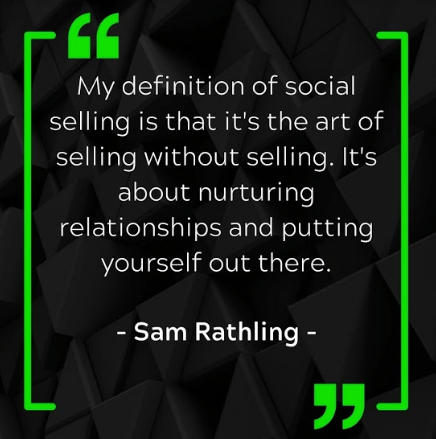
Episodic Artwork (It’s great to keep visual content fresh for your followers. For interview episodes, feature the guest to increase your chances of them sharing the imagery).
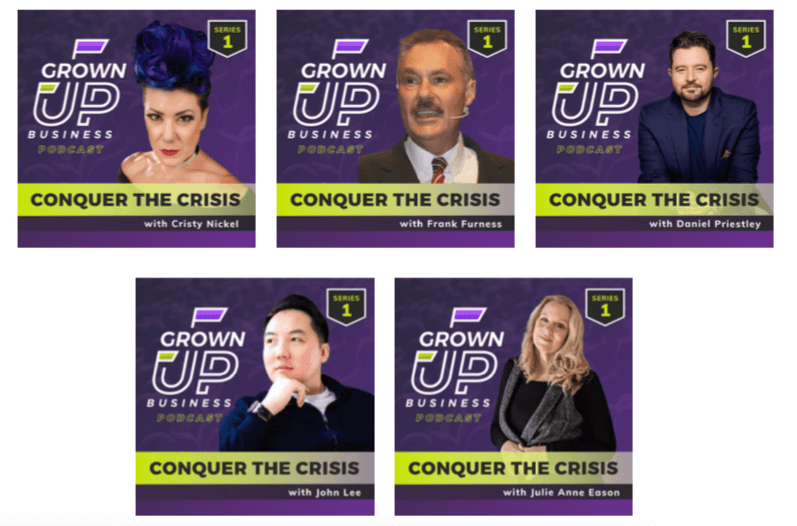
Your Podcast Is Ready!
I know that this is a lot of info to absorb, but these steps will give you a good idea of what is needed to plan, produce, launch, grow and monetise your very own powerful podcast.
In summary, my biggest recommendation to you is get started. Take some form of action based on what you have seen here;
- Download Audacity and play around with it
- Get your microphone ordered
- Start recording
- Play around with some artwork concepts
- Create a list of dream guests for your show etc.
Whatever small form of action you decide, act now. This medium is genuinely exploding right now and podcasting is fast becoming the most valuable way to gain expert positioning, become the go-to person in your sector and monetise your content, so jump into the warm seas of audio creation, you’ll be glad you did.
And when (notice how I say when not if!) you launch your game-changing podcast make sure you let me know about it so I can check it out! Look forward to hearing the fruits of your labour soon.
- About the Author...






4 Responses
Hi James,
Great article, I was thinking about starting the podcast but was confused on how to start, this article gives me thorough information which helps me a lot in starting my podcast.
Thanks for sharing.
Thanks for commenting John.
James has certainly put together a great guide here.
Good luck with your podcast – and if there’s anything missing, don’t be afraid to ask.
Really enjoyed reading this!
Quality podcasts are important to attract the right people!